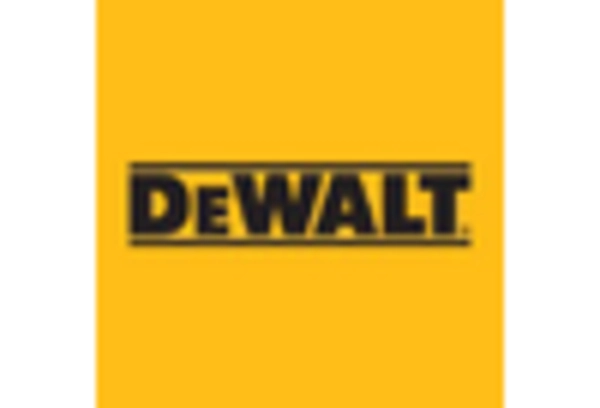Emergence of E-commerce in Angle Grinder Market
The rise of e-commerce is transforming the purchasing landscape within the Angle Grinder Market. Consumers are increasingly turning to online platforms for their tool purchases, attracted by the convenience and variety offered. E-commerce platforms provide access to a broader range of products, including specialized angle grinders that may not be available in traditional retail stores. Additionally, the ability to compare prices and read customer reviews online is influencing consumer behavior, leading to more informed purchasing decisions. Recent data suggests that online sales of power tools, including angle grinders, are expected to grow significantly, potentially outpacing traditional retail sales. This shift towards e-commerce is likely to reshape the competitive dynamics of the angle grinder market, as manufacturers and retailers adapt to meet the changing preferences of consumers.
Technological Advancements in Angle Grinder Market
The Angle Grinder Market is experiencing a notable transformation due to rapid technological advancements. Innovations such as brushless motors and improved battery technologies are enhancing the efficiency and performance of angle grinders. These advancements not only increase the power-to-weight ratio but also extend the operational life of the tools. For instance, the introduction of smart angle grinders equipped with IoT capabilities allows for real-time monitoring and diagnostics, which can significantly reduce downtime. Furthermore, the integration of advanced safety features, such as automatic shut-off mechanisms, is likely to appeal to both professional and amateur users. As a result, the demand for technologically advanced angle grinders is expected to rise, driving growth in the market.
Increased Focus on Safety Standards in Angle Grinder Market
Safety standards are becoming increasingly stringent within the Angle Grinder Market, driven by a heightened awareness of workplace safety. Regulatory bodies are implementing more rigorous guidelines to ensure that tools meet specific safety criteria, which is likely to influence purchasing decisions among consumers. Manufacturers are responding by designing angle grinders that incorporate enhanced safety features, such as anti-kickback systems and improved grip designs. This focus on safety not only protects users but also enhances the overall reputation of brands within the market. As a result, the emphasis on safety is expected to drive innovation and growth in the angle grinder market, as consumers seek tools that comply with the latest safety regulations.
Rising Demand from Construction Sector in Angle Grinder Market
The construction sector plays a pivotal role in the growth of the Angle Grinder Market. With the ongoing expansion of infrastructure projects and residential developments, the demand for angle grinders is surging. According to recent data, the construction industry is projected to grow at a compound annual growth rate of approximately 5.5% over the next few years. This growth is likely to be accompanied by an increased need for efficient and versatile tools, such as angle grinders, which are essential for cutting, grinding, and polishing various materials. Additionally, the trend towards prefabrication in construction is further propelling the need for high-performance angle grinders, as they are crucial for achieving precision in manufacturing processes. Consequently, the construction sector's expansion is expected to significantly influence the angle grinder market.
Growth of the Metal Fabrication Industry in Angle Grinder Market
The metal fabrication industry is a significant driver of growth in the Angle Grinder Market. As industries such as automotive, aerospace, and manufacturing continue to expand, the demand for metal fabrication processes is increasing. Angle grinders are essential tools in these processes, utilized for cutting, grinding, and finishing metal surfaces. Recent statistics indicate that the metal fabrication market is expected to grow at a rate of around 4.2% annually, which will likely lead to a corresponding increase in the demand for angle grinders. Furthermore, the trend towards automation in metal fabrication is also influencing the market, as manufacturers seek to integrate advanced tools that enhance productivity and precision. This growth in the metal fabrication sector is poised to have a substantial impact on the angle grinder market.


















Leave a Comment